Complementary roles of cholecystokinin- and parvalbumin-expressing GABAergic neurons in hippocampal network oscillations
- PMID: 16237182
- PMCID: PMC6725722
- DOI: 10.1523/JNEUROSCI.3269-05.2005
Complementary roles of cholecystokinin- and parvalbumin-expressing GABAergic neurons in hippocampal network oscillations
Abstract
In the hippocampal CA1 area, a relatively homogenous population of pyramidal cells is accompanied by a diversity of GABAergic interneurons. Previously, we found that parvalbumin-expressing basket, axo-axonic, bistratified, and oriens-lacunosum moleculare cells, innervating different domains of pyramidal cells, have distinct firing patterns during network oscillations in vivo. A second family of interneurons, expressing cholecystokinin but not parvalbumin, is known to target the same domains of pyramidal cells as do the parvalbumin cells. To test the temporal activity of these independent and parallel GABAergic inputs, we recorded the precise spike timing of identified cholecystokinin interneurons during hippocampal network oscillations in anesthetized rats and determined their molecular expression profiles and synaptic targets. The cells were cannabinoid receptor type 1 immunopositive. Contrary to the stereotyped firing of parvalbumin interneurons, cholecystokinin-expressing basket and dendrite-innervating cells discharge, on average, with 1.7 +/- 2.0 Hz during high-frequency ripple oscillations in an episode-dependent manner. During theta oscillations, cholecystokinin-expressing interneurons fire with 8.8 +/- 3.3 Hz at a characteristic time on the ascending phase of theta waves (155 +/- 81 degrees), when place cells start firing in freely moving animals. The firing patterns of some interneurons recorded in drug-free behaving rats were similar to cholecystokinin cells in anesthetized animals. Our results demonstrate that cholecystokinin- and parvalbumin-expressing interneurons make different contributions to network oscillations and play distinct roles in different brain states. We suggest that the specific spike timing of cholecystokinin interneurons and their sensitivity to endocannabinoids might contribute to differentiate subgroups of pyramidal cells forming neuronal assemblies, whereas parvalbumin interneurons contribute to synchronizing the entire network.
Figures
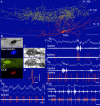
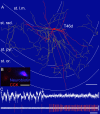
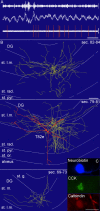
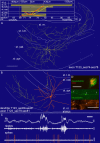


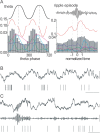
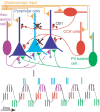
Similar articles
-
Cell type-specific tuning of hippocampal interneuron firing during gamma oscillations in vivo.J Neurosci. 2007 Aug 1;27(31):8184-9. doi: 10.1523/JNEUROSCI.1685-07.2007. J Neurosci. 2007. PMID: 17670965 Free PMC article.
-
Properties and dynamics of inhibitory synaptic communication within the CA3 microcircuits of pyramidal cells and interneurons expressing parvalbumin or cholecystokinin.J Physiol. 2016 Jul 1;594(13):3745-74. doi: 10.1113/JP272231. Epub 2016 May 5. J Physiol. 2016. PMID: 27038232 Free PMC article.
-
Temporal redistribution of inhibition over neuronal subcellular domains underlies state-dependent rhythmic change of excitability in the hippocampus.Philos Trans R Soc Lond B Biol Sci. 2013 Dec 23;369(1635):20120518. doi: 10.1098/rstb.2012.0518. Print 2014 Feb 5. Philos Trans R Soc Lond B Biol Sci. 2013. PMID: 24366131 Free PMC article.
-
Functional characteristics of parvalbumin- and cholecystokinin-expressing basket cells.J Physiol. 2012 Feb 15;590(4):669-81. doi: 10.1113/jphysiol.2011.226175. Epub 2012 Jan 16. J Physiol. 2012. PMID: 22250212 Free PMC article. Review.
-
GABAergic interneurons targeting dendrites of pyramidal cells in the CA1 area of the hippocampus.Eur J Neurosci. 2009 Sep;30(6):947-57. doi: 10.1111/j.1460-9568.2009.06913.x. Epub 2009 Sep 4. Eur J Neurosci. 2009. PMID: 19735288 Review.
Cited by
-
BDNF Depresses Excitability of Parvalbumin-Positive Interneurons through an M-Like Current in Rat Dentate Gyrus.PLoS One. 2013 Jun 19;8(6):e67318. doi: 10.1371/journal.pone.0067318. Print 2013. PLoS One. 2013. PMID: 23840662 Free PMC article.
-
GABAergic System Dysfunction and Challenges in Schizophrenia Research.Front Cell Dev Biol. 2021 May 14;9:663854. doi: 10.3389/fcell.2021.663854. eCollection 2021. Front Cell Dev Biol. 2021. PMID: 34055795 Free PMC article. Review.
-
Distinct Functional Groups Emerge from the Intrinsic Properties of Molecularly Identified Entorhinal Interneurons and Principal Cells.Cereb Cortex. 2017 Jun 1;27(6):3186-3207. doi: 10.1093/cercor/bhw143. Cereb Cortex. 2017. PMID: 27269961 Free PMC article.
-
Activation of Metabotropic Glutamate Receptor 7 Is Required for Induction of Long-Term Potentiation at SC-CA1 Synapses in the Hippocampus.J Neurosci. 2015 May 13;35(19):7600-15. doi: 10.1523/JNEUROSCI.4543-14.2015. J Neurosci. 2015. PMID: 25972184 Free PMC article.
-
Specific Hippocampal Interneurons Shape Consolidation of Recognition Memory.Cell Rep. 2020 Aug 18;32(7):108046. doi: 10.1016/j.celrep.2020.108046. Cell Rep. 2020. PMID: 32814049 Free PMC article.
References
-
- Acsady L, Arabadzisz D, Freund TF (1996) Correlated morphological and neurochemical features identify different subsets of vasoactive intestinal polypeptide-immunoreactive interneurons in rat hippocampus. Neuroscience 73: 299-315. - PubMed
-
- Buzsaki G, Draguhn A (2004) Neuronal oscillations in cortical networks. Science 304: 1926-1929. - PubMed
-
- Buzsaki G, Leung L-W, Vanderwolf CH (1983) Cellular bases of hippocampal EEG in the behaving rat. Brain Res Brain Res Rev 6: 139-171. - PubMed
-
- Carlson G, Wang Y, Alger BE (2002) Endocannabinoids facilitate the induction of LTP in the hippocampus. Nat Neurosci 5: 723-724. - PubMed
Publication types
MeSH terms
Substances
LinkOut - more resources
Full Text Sources
Miscellaneous
